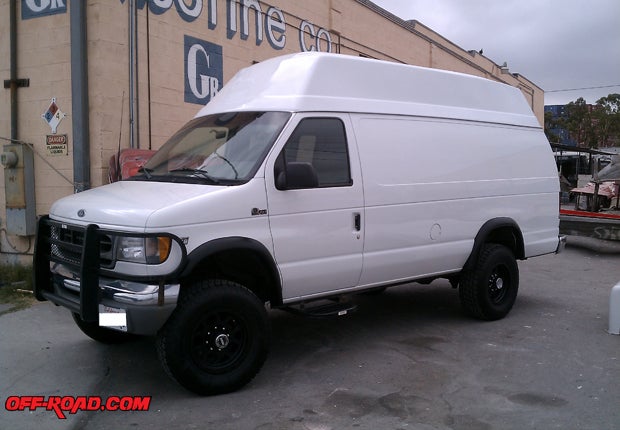
If you recall from our first installment of Project Motovan, we were forced to use the original spare tire after puncturing the existing tire while trying to get the van off the moving truck. Since the van is going to be used as a daily driver for at least a few months having a functioning spare tire is essential. Besides needing a new spare, the date stamp on the remaining tires showed 2003, making those tires about 7 years old. Recommendations on replacing used tires ranges from 6 to 10 years depending on which research you read. If we were already buying one new tire, now seemed to be the right time to go ahead and replace all the tires and think about upgrading our rims as well.
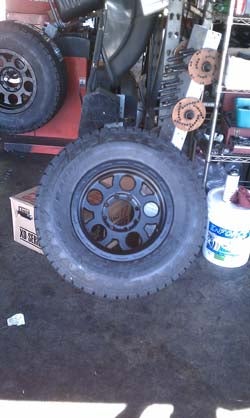 With all the different tire options out there we really needed some help on deciding what was going to be best for our needs. We had to figure out which size tire and rim would fit, which tread pattern would be most practical and what the appropriate load range should be for our Quigley 4x4. What we didn’t want was a tire-and-rim combo that hit the fenders or a tire too wide that would contact the steering components. On a recommendation from a friend, we made a call to Sarah at Northridge Tire Pros in Northridge, CA. We immediately felt comfortable that Sarah knew exactly what she was talking about and stopped by the store so she could look over the van and help give us some suggestions.
With all the different tire options out there we really needed some help on deciding what was going to be best for our needs. We had to figure out which size tire and rim would fit, which tread pattern would be most practical and what the appropriate load range should be for our Quigley 4x4. What we didn’t want was a tire-and-rim combo that hit the fenders or a tire too wide that would contact the steering components. On a recommendation from a friend, we made a call to Sarah at Northridge Tire Pros in Northridge, CA. We immediately felt comfortable that Sarah knew exactly what she was talking about and stopped by the store so she could look over the van and help give us some suggestions.
Perhaps the most important decision we had to make before settling on any tire or rim was to figure out what load range tire we needed. Since our E-350 Quigley 4x4 weighed in at 6700 pounds empty when we bought it, we knew after adding the interior and other aftermarket components it could easily hit 10,000 pounds. Discussing these loads with Sarah led us to settle on a tire with a load range rating of E. The pluses of an E rated tire are that they are capable of handling our expected weight and loads and provide us with good sidewall stiffness for highway driving. The negatives are that when aired down off-road they are still rather stiff and don’t conform as well to the terrain as say a load range C or D rated tire. Still, sighting safety as number one and the fact that we don’t plan on doing any hard core four-wheeling with the van, the load range E rated tire seemed to be the obvious choice.
Choosing a load range E tire limits the available tire choices in a hurry! There are not a lot of companies that make off-road-oriented tires that come in load range E. Within those off-road tires rated at load range E we narrowed down our selection even further to those that were best suited to our planned highway and general off-road use. We came up with the BF Goodrich All-Terrain, the Toyo Open Country All-Terrain and the Nitto Terra Grappler All-Terrain. After doing some research on user opinions of the above mentioned tires we settled on the Nitto Terra Grappler All-Terrains. We found many reviews praising these tires for ride quality, traction on and off-road as well as being quiet. The other nice feature of the Nitto’s is that they come with an all-season mud and snow rating.
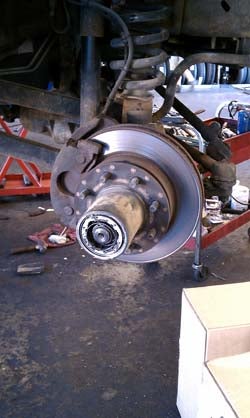 For our rim selection, we needed to also make sure we chose a rim that was also rated to support the weight of the van. Many rims may look cool but are designed for lightweight pickups and not 3/4-ton vehicles. Although people still choose to run these types of rims, on heavier vehicles it can be asking for trouble, especially if carrying a load or off-roading. After doing some research, we settled on the KMC Enduro 17-inch rims in black. KMC has a good reputation in the off-road world of having a durable product that has been proven in off-road racing competition. Some folks will say going with a 17 inch rim limits your choice in tires and to some extent that is true. However, for our specific needs a 17 inch rim will provide better highway performance while still leaving a good amount of sidewall protection from the tires in off-road settings.
For our rim selection, we needed to also make sure we chose a rim that was also rated to support the weight of the van. Many rims may look cool but are designed for lightweight pickups and not 3/4-ton vehicles. Although people still choose to run these types of rims, on heavier vehicles it can be asking for trouble, especially if carrying a load or off-roading. After doing some research, we settled on the KMC Enduro 17-inch rims in black. KMC has a good reputation in the off-road world of having a durable product that has been proven in off-road racing competition. Some folks will say going with a 17 inch rim limits your choice in tires and to some extent that is true. However, for our specific needs a 17 inch rim will provide better highway performance while still leaving a good amount of sidewall protection from the tires in off-road settings.
Looking at the clearance around the fenders and steering components with the stock 245/75/R16 tires, Sarah recommended going with a 285/75/R17 tire, which equates to just about a 33-inch tire. We may have been able to squeeze in a little taller 295, but going wider that the 75 would probably end up with wheel rub on the steering components at one, or both, ends. Even with the 285s we still ended up doing a little trimming on the front bumper and behind the front tire on the lower part of the fender to make sure that mild off-road use wouldn’t result in damaging a tire or crunching a fender. Although the new tires didn’t really stick out past the stock fenders much when straight, we opted to also have Sarah install a set of Bushwacker fender flares to help keep mud, water and debris off the sides of the van. We also took the opportunity to have the front brakes serviced and bearings repacked.
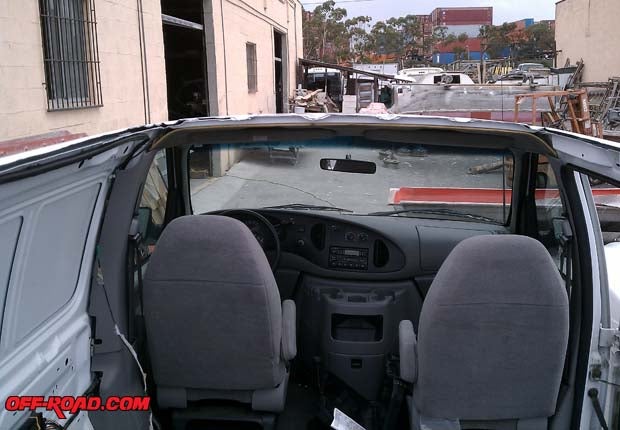
With over two months on the tires we are extremely happy with our decision. The Nitto Terra Grappler All-Terrains are super quiet on the highway and seem to offer good traction both on the dry and wet pavement. We haven’t had a chance to do any off-roading yet but anticipate good traction there as well. At times, the 285s look plenty big on the van and at other times they look a size too small. Our van came with 3.55 gearing front and rear so going with tires any larger didn’t seem like a wise move, even though the 7.3 has plenty of torque. Plus, we really don’t want to throw money at gearing until the van is done and we get an idea of how much it weighs and how it operates in its finished condition. With the van currently empty, the current 3.55 gearing has no trouble at all turning the 285s, although we do notice a little less pep when stepping on it.
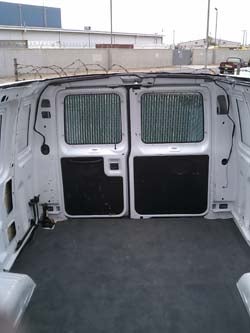 Moving on to perhaps the biggest decision of the build, even bigger than tire and rim selection, is that of selecting the right top for the van. Adding a top is optional of course, but since our van will be used as a camper as well as a moto hauler, we feel that the need for standing room is a necessity for overall comfort. In our previous article we mentioned the Sportsmobile “Penthouse” canvas pop-top option. This item can be added by Sportsmobile to almost any new or used Ford, Chevy or Dodge van. It stows away while not in use and pops up when at camp. The idea of having the ability to pop up the top and open all the windows up at the beach or in the forest sounds simply amazing. In addition, since it stows away when not in use, the van is close to its original roof height for maneuvering in the city or in tree covered off-road settings.
Moving on to perhaps the biggest decision of the build, even bigger than tire and rim selection, is that of selecting the right top for the van. Adding a top is optional of course, but since our van will be used as a camper as well as a moto hauler, we feel that the need for standing room is a necessity for overall comfort. In our previous article we mentioned the Sportsmobile “Penthouse” canvas pop-top option. This item can be added by Sportsmobile to almost any new or used Ford, Chevy or Dodge van. It stows away while not in use and pops up when at camp. The idea of having the ability to pop up the top and open all the windows up at the beach or in the forest sounds simply amazing. In addition, since it stows away when not in use, the van is close to its original roof height for maneuvering in the city or in tree covered off-road settings.
Doing my research with other pop-top owners and speaking with Jonathan from Sportsmobile, I came to the conclusion the pop-top is plenty durable to withstand wind, rain and snow. In fact, I have seen photos of vans with the Sportsmobile pop-top up in the middle of winter covered in snow. The main downfall of this type of top however is the heat and cooling loss you get through the canvas sides. While this may not a be a big deal to some folks who do mostly beach or forest camping in mild environments, our van will be seeing nights in the desert during the winter when the temps are commonly in the 30s and the winds are howling. In contrast to the cold temps, our van will also make visits to the desert during the summer when the temps can hover around 100 degrees during the day. Being able to maintain consistent temps efficiently during the harsh desert environments we started leaning toward exploring more hard-top options for Project Motovan.
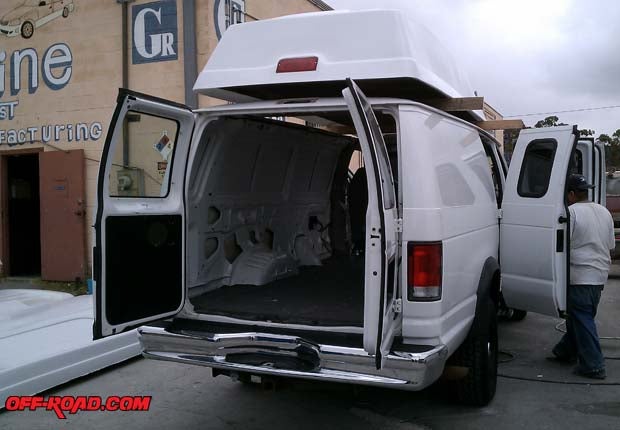
Besides more consistent temps, hardtops also have some other advantages over a pop-top. When on the road, you can stop anytime you want and walk around the van without having to raise and lower the top. Hard tops also offer the opportunity to install permanent cabinets up along the sides, front and back if desired. This extra space can be a real benefit when carrying both camping and moto gear. Scrolling through the pages of the Sportsmobile website revealed a few different hard-top options. The “Voyager” style top they offer looked to be about the best compromise between maximizing space while still keeping it somewhat streamlined.
With a few e-mails to Jonathan it was quickly apparent that many other folks currently have the same idea of building a camper van. There was almost a three-month wait to have them install either top, or do any other work for that matter. With the state of today’s economy it is great to see them doing so well, but for us it meant a hit to our schedule we couldn’t afford.
With the Sportsmobile Voyager top out of the question due to our project schedule, we began looking around for other options. We came across a small business called Fiberine located in Southern California. After exchanging a few phone calls and photos it appeared we could go with Fiberine’s 24” “Bubble Top.” The top used a newer style “reverse flange” design that fits flush up against the rain gutters and reduces any chances for leaks. They didn’t have the interior finishing options that Sportsmobile offered but they could reinforce the top with wood and could also fit us in within a week or two so it was a go.
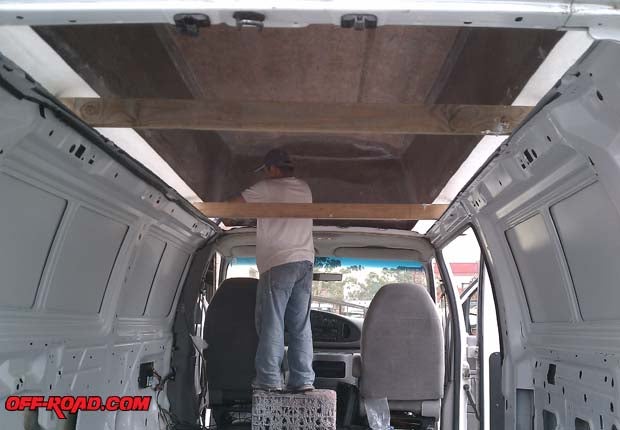
Arriving at Fiberine I was a bit nervous knowing I was about to have the top cut off my perfectly good Quigley. A little unsettling but I knew I needed to forge ahead if I really wanted to have a functional and comfortable camper van. After removing the headliner, the worker drilled four pilot holes at each corner from the inside. Then he climbed up on top and outlined the top with painters tape, using the four pilot holes as guides. Next thing you know an air chisel was running full bore cutting off the top. Yikes! A little while later, the Quigley was a convertible with some dark clouds looming overhead. Luckily it didn’t’ take too long before I saw a few guys carrying my top along the sidewalk before setting it in place on the roof.
Once in place, they stuck a few planks of wood under the top and started going at it with silicone. After they had a thick bead of silicone all around the top, they removed the wood and set the top in its resting place. Using a bunch of sheet metal screws and then some hefty bolts in a few spots the top was basically complete. They finished the process by hooking up the third brake light and taking a measurement at my request of the height from the ground. It was right at 9 feet high, but you won’t catch me going under anything at least 9’6 due to past experiences of ripping off racks in a parking garage that had misstated the height.
Driving the Project Motovan with the top installed is a little different over stock in that you always need to be aware how high things are you are driving under. For the most part, there shouldn’t be any issues with highway driving, but when heading off-road careful consideration must be given on any trails where branches or under hangs are present. The van is also heavier with the top in place, which has an impact on both acceleration and braking. Although the difference isn’t drastic by any means it is still noticeable. Even with these drawbacks, however, having the hard top really opens the van up when inside, and having room to walk around makes it feel much more like a camper. Not only will the top provide more consistent temps in differing conditions it also provides more security when leaving it at camp to go on a ride.
Now that the tires, rims and hardtop are installed, next up is the interior. Careful Internet searching revealed quite a few companies that do van conversions. Some do simple seating arrangements only, while others focus only on handicap conversions and still others will do some custom work. The main stumbling block with most of these places for our project van is that they won’t touch any chassis work. This means adding batteries to the frame, installing a heater or ACs, or doing work under the hood is out of the question. The thought of driving the van back and forth to different shops to get different types of work done was tiring enough, but adding the stress of wondering if one shop will be able to work with another in getting tasks done didn’t sit too well. We searched high and low and think we have finally ended up with the perfect solution, Colorado Campervan. A new company owned by two van enthusiasts that also ride dirt bikes. Not only do they themselves own 4x4 vans, but they have extensive experience with four-wheeling, wrenching and are not afraid of chassis work! Be sure to read the next installment and follow our progress with phase 1 of the interior build on Project Motovan.


 Your Privacy Choices
Your Privacy Choices